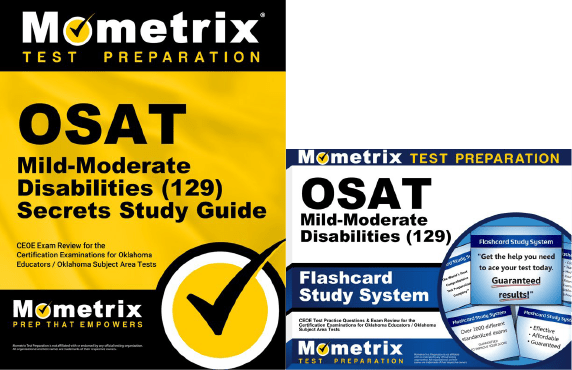If you need help studying for the OSAT Mild-Moderate Disabilities test or just want some more information about what the test is like, you’ve come to the right place!
Click below to take a free OSAT Mild-Moderate Disabilities practice test!
What’s on the Test?
First, let’s talk about the questions on the OSAT Mild-Moderate Disabilities test. There are 81 questions in total, most being selected-response and one being constructed-response.
80 questions
Selected-response questions require you to select the correct answer from a list of options. Multiple-choice questions are the most common example, but you may also see true-or-false questions and “matching” questions, which ask you to match terms or concepts with their definitions.
Constructed-Response (CR)
1 question
The constructed-response question requires you to write your answer instead of selecting from a list of choices. Your response to this question is generally expected to be at least a few sentences, but you’ll be given specific details and instructions before you take the test.
The time limit for the exam is 4 hours. There aren’t any scheduled breaks, but you’re free to take restroom breaks as needed.
Let’s take a closer look at the different sections of the test.
1. Understanding Students with Mild/Moderate Disabilities
12% of the exam
- Human development
- Factors that affect development and learning
- Various types of disabilities
2. Assessing Students and Developing IEPS and IFSPS
12% of the exam
- Assessment instruments
- Evaluating the strengths and needs of students with mild/moderate disabilities
- Referral, eligibility, program planning, instruction, and placement of students with mild/moderate disabilities
3. Learning across the Curriculum
45% of the exam
- Establishing positive and productive learning environments for students with mild/moderate disabilities
- Improving language development and communication skills
- Teaching reading
- Teaching math
- Developing social skills
- Providing effective positive behavior interventions
- Promoting academic achievement and independent learning
- Promoting students’ acquisition of functional skills
- Promoting successful transitions for students
4. Working in a Collaborative Learning Community
35% of the exam
- Effective collaboration and communication processes
- Promoting effective school-home collaborations
- The history and philosophy of special education
- Key issues, trends, professional roles, and legal and ethical issues pertaining to special education
5. Case Study: Analysis of Data to Identify and Effectively Address Student Needs
15% of the exam
Then, you’ll be given specific instructions on what your written response should cover. Your finished response should be between 300 and 600 words.
How to Register
To register for the test, you’ll first need to contact the OSDE so they can ensure you’re eligible to take the exam. Then, you can create an account on the CEOE website. Once your account has been created, you can register to take the exam.
During the registration process, you’ll need to pay the $118 testing fee.
How the Exam is Scored
The OSAT Mild-Moderate Disabilities test is scored using a scaled scoring method. Here’s how it works:
For every question you answer correctly, you get one point added to your raw score. At the end of the test, your final raw score will be converted to a scaled score.
You’ll need a scaled score of at least 240 on each subtest to pass the exam.
The reason your raw score is converted to a scaled score is because everyone that takes the test is given a slightly different set of questions. Since everyone has a different arrangement of questions, and because some questions are harder than others, converting your raw score to a scaled score ensures a more even playing field.
Retaking the Exam
If you don’t get the score you want on your first try, that’s okay! You can take the exam again after a mandatory 30-day waiting period.
FAQs
How many questions are on the OSAT Mild-Moderate Disabilities exam?
The exam contains 81 questions.
What is the time limit for the OSAT Mild-Moderate Disabilities exam?
The exam is timed at 4 hours.
What is the passing score for the OSAT Mild-Moderate Disabilities exam?
You’ll need to get a final scaled score of at least 240 to pass.
How much does the OSAT Mild-Moderate Disabilities exam cost?
The testing fee is $118.



 OSAT Study Guide
OSAT Study Guide OSAT Flashcards
OSAT Flashcards